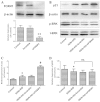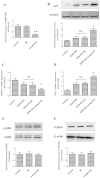miRNA-130b is required for the ERK/FOXM1 pathway activation-mediated protective effects of isosorbide dinitrate against mesenchymal stem cell senescence induced by high glucose
- PMID: 25355277
- PMCID: PMC4249746
- DOI: 10.3892/ijmm.2014.1985
miRNA-130b is required for the ERK/FOXM1 pathway activation-mediated protective effects of isosorbide dinitrate against mesenchymal stem cell senescence induced by high glucose
Abstract
The present study was carried out to investigate the hypothesis that organic nitrates can attenuate the senescence of mesenchymal stem cells (MSCs), a superior cell source involved in the regeneration and repair of damaged tissue. MSCs were treated with high glucose (HG) in order to induce senescence, which was markedly attenuated by pre-treatment with isosorbide dinitrate (ISDN), a commonly used nitrate, as indicated by senescence-associated galactosidase (SA-β-gal) activity, p21 expression, as well as by the mRNA levels of DNA methyltransferase 1 (DNMT1) and differentiated embryo chondrocyte expressed gene 1 (DEC1), which are senescence-related biomarkers. It was also found that the senescent MSCs (induced by HG glucose) exhibited a marked downregulation in ERK activity and forkhead box M1 (FOXM1) expression, which was reversed by ISDN preconditioning. Of note, the inhibition of ERK phosphorylation or the downregulation of FOXM1 statistically abolished the favourable effects of ISDN. In addition, the investigation of the senescence-associated miR-130 family suggested that miR-130b mediates the beneficial effects of ISDN; it was found that the protective effects of ISDN against the senescence of MSCs were prominently reversed by the knockdown of miR-130b. Furthermore, the downregulation of ERK phosphorylation or FOXM1 expression decreased the miR-130b expression level; however, the suppression of miR-130b demonstrated no significant impact on ERK phosphorylation or FOXM1 expression. Taken together, to the best of our knowledge, the present study is the first to demonstrate the favourable effects of ISDN against HG-induced MSC senescence, which are mediated through the activation of the ERK/FOXM1 pathway and the upregulation of miR-130b.
Figures









Similar articles
-
Activated ERK/FOXM1 pathway by low-power laser irradiation inhibits UVB-induced senescence through down-regulating p21 expression.J Cell Physiol. 2014 Jan;229(1):108-16. doi: 10.1002/jcp.24425. J Cell Physiol. 2014. PMID: 23804320
-
miR-34a induces cellular senescence via modulation of telomerase activity in human hepatocellular carcinoma by targeting FoxM1/c-Myc pathway.Oncotarget. 2015 Feb 28;6(6):3988-4004. doi: 10.18632/oncotarget.2905. Oncotarget. 2015. PMID: 25686834 Free PMC article.
-
miR-290 acts as a physiological effector of senescence in mouse embryo fibroblasts.Physiol Genomics. 2009 Nov 6;39(3):210-8. doi: 10.1152/physiolgenomics.00085.2009. Epub 2009 Sep 1. Physiol Genomics. 2009. PMID: 19723773
-
Senescence of mesenchymal stem cells (Review).Int J Mol Med. 2017 Apr;39(4):775-782. doi: 10.3892/ijmm.2017.2912. Epub 2017 Mar 9. Int J Mol Med. 2017. PMID: 28290609 Review.
-
[MSC Senescence-related Signaling Pathway - Review].Zhongguo Shi Yan Xue Ye Xue Za Zhi. 2018 Feb;26(1):307-310. doi: 10.7534/j.issn.1009-2137.2018.01.055. Zhongguo Shi Yan Xue Ye Xue Za Zhi. 2018. PMID: 29397864 Review. Chinese.
Cited by
-
Non-Coding RNAs Steering the Senescence-Related Progress, Properties, and Application of Mesenchymal Stem Cells.Front Cell Dev Biol. 2021 Mar 19;9:650431. doi: 10.3389/fcell.2021.650431. eCollection 2021. Front Cell Dev Biol. 2021. PMID: 33816501 Free PMC article. Review.
-
Adipose-Derived Stem Cells Preincubated with Green Tea EGCG Enhance Pancreatic Tissue Regeneration in Rats with Type 1 Diabetes through ROS/Sirt1 Signaling Regulation.Int J Mol Sci. 2022 Mar 15;23(6):3165. doi: 10.3390/ijms23063165. Int J Mol Sci. 2022. PMID: 35328586 Free PMC article.
-
Prognostic values of microRNA-130 family expression in patients with cancer: a meta-analysis and database test.J Transl Med. 2019 Oct 22;17(1):347. doi: 10.1186/s12967-019-2093-y. J Transl Med. 2019. PMID: 31640738 Free PMC article.
-
In search of elixir: Pharmacological agents against stem cell senescence.Iran J Basic Med Sci. 2021 Jul;24(7):868-880. doi: 10.22038/ijbms.2021.51917.11773. Iran J Basic Med Sci. 2021. PMID: 34712416 Free PMC article. Review.
-
Forkhead box M1 inhibits endothelial cell apoptosis and cell-cycle arrest through ROS generation.Int J Clin Exp Pathol. 2018 Oct 1;11(10):4899-4907. eCollection 2018. Int J Clin Exp Pathol. 2018. PMID: 31949565 Free PMC article.
References
-
- Sung YH, Shin MS, Ko IG, et al. Ulinastatin suppresses lipopolysaccharide-induced prostaglandin E-2 synthesis and nitric oxide production through the downregulation of nuclear factor-κB in BV2 mouse microglial cells. Int J Mol Med. 2013;31:1030–1036. - PubMed
-
- Xu J, Qian J, Xie X, et al. High density lipoprotein cholesterol promotes the proliferation of bone-derived mesenchymal stem cells via binding scavenger receptor-B type I and activation of PI3K/Akt, MAPK/ERK1/2 pathways. Mol Cell Biochem. 2012;371:55–64. doi: 10.1007/s11010-012-1422-8. - DOI - PubMed
Publication types
MeSH terms
Substances
LinkOut - more resources
Full Text Sources
Other Literature Sources
Miscellaneous

